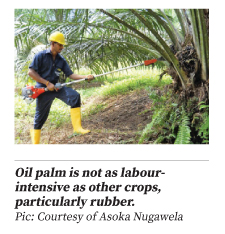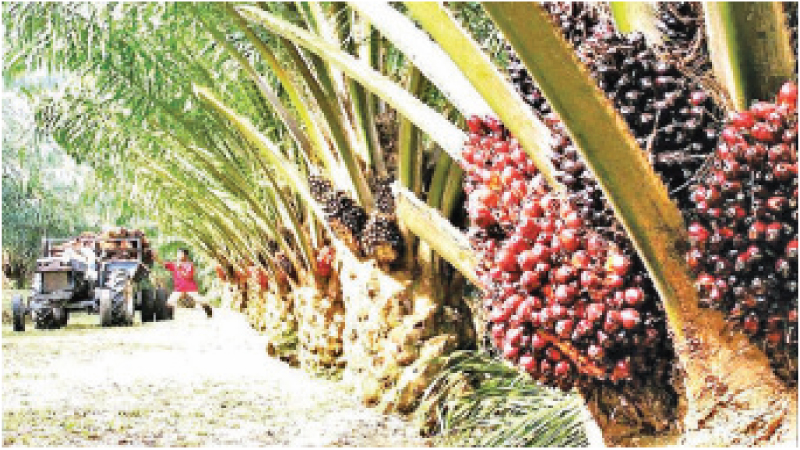It’s a crying shame to see that the authorities have cold shouldered the oil palm plantations which could not only bring economic wellbeing to agro communities but can also save a huge amount of forex which is drained on import of edible oils, said Director/Agriculture Education Unit, University of Peradeniya, Prof. Buddhi Marambe.
The foreign exchange spent on importing vegetable oil is approximately 65% of the total export earnings from coconut kernel products.
 He said that though there were several theories that palm oil could damage the environment it is not so. “These are all fears created by pressure groups based on non-scientific evidence.”
He said that though there were several theories that palm oil could damage the environment it is not so. “These are all fears created by pressure groups based on non-scientific evidence.”
He said that hence oil palm cultivation should be permitted again and as it will give a better return.
“However, the authorities must ensure that oil palm cultivators do not use forest land for cultivation.”
He said he endorses the move to replace aging rubber or tea plantations with oil palm. “A farmer can definitely get more than what he earns from both rubber and tea by venturing into oil palm cultivation.”
This is also not a labour intensive crop and hence a grower can also engage in another business to supplement his income.
Palm oil is the world’s most widely used industrial frying fat used to make cooking oil and frying fat, margarines, shortenings, Vanaspati, bakery fat, palm stearin and palm olein, cereals bars, noodles, potato chips, chocolates, confectionery, caramel, toffee and fudges, non-dairy creamers, ice cream, processed cheese, yoghurt, soup mixes and animal feed and also for bio-diesel.
Palm oil is currently the most consumed edible oil in the world. Global edible oil production has increased with a CAGR of around 4% over the past decades. The demand and consumption of palm oil has increased by over 200% over the past three decades.
Palm oil ban
The palm oil cultivation which was egged on by the Government previously suddenly took a u-turn in 2021 when a panel of environmental experts made recommendations from a 2018 report linking oil palm plantations to soil erosion and the drying up of water sources. Regional Plantation companies had by this time, invested around Rs. 500 million to put up nurseries and today this investment had gone down the drain as these plants are now no use.
An Emeritus Professor in the Faculty of Agriculture at Wayamba University, Asoka Nugawela, took issue with the CEA expert panel’s suggestion that oil palm plantations could dry up local water sources.
He said oil palm in Sri Lanka is generally cultivated in areas where annual rainfall exceeds 3,500 millimeters (138 inches), while their water requirement is about 1,300 mm (51 in). So the argument that they could cause springs to run dry isn’t true, Nugawela said.
“If you visit oil palm plantations, you can witness healthily flowing streams full of life,” he said.
Nugawela said that the Nakiyadeniya estate, Sri Lanka’s first oil palm plantation, has been running now for over 50 years, with no sign of water problems in the area. A 2018 study described a new species of freshwater fish in a stream in Nakiyadeniya; Nugawela said this proves that the streams drying up argument is unfounded.
The Palm Oil Industry Association of Sri Lanka (POIA) has also rejected the expert panel’s recommendations that justify the ban, and has called the science into question. It says companies have invested heavily in oil palm cultivation with the encouragement of successive governments and will be appealing against the ban. “It’s strange to note that Sri Lanka was the only country to ban palm oil and that this fact itself suggested that there was something wrong in that decision,” a POIA spokesman said.
An official from the Small and Medium-Scale Planters’ Association said growers incurred a monthly income loss of around Rs. 75,000 due to the 2021 ban. “We also know that currently the best agro plantation of this nature to get high yield is growing palm oil and we call on the Government to lift the ban soon.”
Global palm oil industry
The demand and consumption of palm oil has increased by over 200% over the past three decades.
This is as a result due to industrialisation, population growth and because palm oil being a healthier and more cost-effective alternative to animal fat. Palm oil has been identified as a more economically viable product due to its versatility and land use to output efficiency.
Most of the regional economies (i.e., India) are highly dependent on palm oil and remain to be net importers of palm oil due to high demand.
Oil palm industry in Sri Lanka
Total edible and non-edible oil requirement: 180,000 MT, Edible oil requirement: 90,000 MT, local palm oil production: 25,000-28,000 (30% of local oil production and 19% of the total oil supply).
In 2021, 67,679 MT of coconut oil and 29,731 MT of palm oil were locally produced, and 202,289 MT of oil was imported at a cost Rs. 57 billion (Monthly Bulletin of the Coconut Development Authority, December 2022). If 20,000 ha of oil palm were cultivated in Sri Lanka (as planned in 2014), 50% of the total edible requirement would have been fulfilled from the locally produced palm oil in a plantation extent of 11,000 ha (1% of total agricultural land extent), cultivated in Galle, Kalutara, Ratnapura, Matara and Kegalle districts.
Saving foreign exchange by the reduction of vegetable oil imports, reducing the variations of the prices for coconuts in the local market, sustainable use of the land, use of uncultivated bare land, supply of quality palm oil to the local market would a few benefits the country could achieve by lifting the ban.
There are over 3,000 small and medium oil palm smallholders who are eagerly waiting the lifting of the ban imposed in 2012 for them to restart cultivation again.
“Economic comparisons reveal that oil palm generates an average profit of Rs. 1,300,000 per hectare per year, outperforming coconut (Rs. 315,000), rubber (Rs. 90,000), and tea (Rs. 600,000),” said Nimal Wijesinghe of HDS.
“Monthly wages for workers in the oil palm sector range from Rs. 50,000 to 100,000 surpassing those in tea (Rs. 25,000) and rubber (Rs. 18,000) industries.”
Women members from HDS said that when engaging in tea plucking they have to leave the home for several hours and this creates many social problems as they have to leave their children at home.




